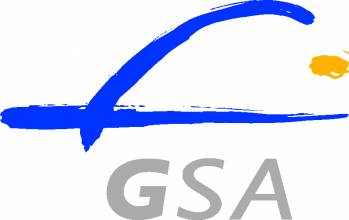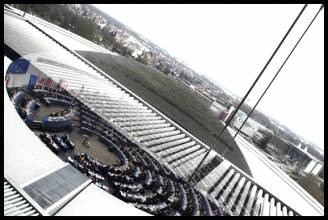
Coming nearly full circle and yet ending up in a new place with a new name describes the peculiar fortunes of the European GNSS Agency, an unlikely fate perhaps reflected most clearly in its continued use of its predecessor’s acronym, GSA.
Five years ago when Europe’s GNSS program abandoned its seemingly misconceived and now roundly condemned effort to forge a public-private partnership (PPP) to develop Galileo, the original GSA — the Galileo Supervisory Authority — appeared orphaned, bereft of purpose and patrons.
Coming nearly full circle and yet ending up in a new place with a new name describes the peculiar fortunes of the European GNSS Agency, an unlikely fate perhaps reflected most clearly in its continued use of its predecessor’s acronym, GSA.
Five years ago when Europe’s GNSS program abandoned its seemingly misconceived and now roundly condemned effort to forge a public-private partnership (PPP) to develop Galileo, the original GSA — the Galileo Supervisory Authority — appeared orphaned, bereft of purpose and patrons.
Primarily envisaged as providing public oversight for a contract with the private consortium that would actually build and operate Galileo, the very existence of the GSA seemed in doubt as PPP reached its long-predicted dead end in 2007.
Today, however, under new leadership and with a newly redefined and broadened mandate, the agency appears likely to handle the bulk of the funds expected to be allocated for Europe’s GNSS programs under the seven-year budget that begins in 2014. These will support the rollout of the Galileo security monitoring system, market development, and near-term responsibility for letting contracts for private operators to provide European GNSS services.
The GSA has opened new headquarters in Prague, broken ground on the first of two Galileo Security Monitoring Centers (GSMCs) in St. Germaine-en-Laye with another to follow in Swanwick, England, and helped organize the recent European Space Solutions conference in London, England. <https://www.insidegnss.com/node/3321>
A new regulation spelling out these duties — and complementary roles of the European Commission and European Space Agency (ESA) — is nearing completion in the European Parliament. The regulation will enter into force in 2014 for seven years.
Final approval is expected early in 2013, according to Silvia Bartolini, a member of the cabinet of Antonio Tajani, European Commission (EC) vice-president who also heads the EC Directorate-General for Enterprise and Industry.
But first the GSA needs to get through the coming months during which its plans for expansion may encounter financial constraints.
On November 16 European Council President Herman van Rompuy proposed a Galileo budget of €6.6 billion, down from the €7 billion (US$9.41 billion) sought by the EC for the next MFF cycle.
MFF funding also is needed to support the European Geostationary Navigation Overlay Service (EGNOS), a satellite-based augmentation system that broadcasts real-time differential corrections for GPS signals and also is slated to come under the GSA responsibilities.
“The Commission doesn’t want the GSA to die, but it also doesn’t want to fund it,” one observer close to the European GNSS program told Inside GNSS.
The GSA’s difficulties are multiplied by a broader struggle over the budget — known formally as the 2014–2020 multiannual financial framework (MFF) — against the background of a European Union (EU) struggling to hold together its common currency, financial system, economy, and even membership.
In an exclusive interview with Inside GNSS, GSA Executive Director Carlo des Dorides, who assumed the position early last year, outlined the prospects and challenges for the agency in the years ahead.
“The new regulation is bringing a new chapter for the agency,” he says. “The GSA has been brought back to the center of the program.”
Even though the GNSS regulation and MFF budget still await final approval, the GSA is proceeding as though they were in place. Under the regulation, the commission will delegate to the GSA management of EGNOS and Galileo, and the agency will be responsible for most of the €6.3–6.4 that des Dorides expects will ultimately be awarded to Europe’s GNSS programs.
Vendor proposals in response to the GSA’s “negotiated call for tenders” were received at the end of November, and des Dorides expects that the agency will award an eight-year contract by June 2013. " That’s the first milestone," he says. "As of January 2014, the GSA will be fully in charge of EGNOS."
Operation, maintenance, and provision of EGNOS services has been handled since 2009 by the European Satellite Services Provider (ESSP) SAS under a contract with the European Commission. This contract expires on December 31, 2013.
The same process will be followed for selecting an operator to provide Galileo services, says des Dorides, with the bid process beginning around the end of 2013 or early 2014. He adds that an “early service” declaration is planned by the end of 2014 based on 14 satellites — four in-orbit validation (IOV) spacecraft now in orbit and 10 additional full operational capability (FOC) satellites to be launched in the interim.
That will still leave the program well off the long-sought goal of an FOC system by 2008. When Galileo began taking form in the late 1990s, it seemed likely to become the world’s second GNSS system after GPS, as Russia’s GLONASS was dwindling rapidly.
Since then, Europe’s program — suffering from technical delays and political detours, such as PPP — has been passed not only by a revitalized GLONASS program but China’s Compass/BeiDou-2 system, which some believe will be completed by 2016, not the official 2020 date.
That’s why the GSA is tasked with such non-technical missions as promoting use of Galileo and EGNOS to industry and end users — reflected in a market studies, the applications-oriented European Space Expo traveling exhibition, and the recent London conference. Des Dorides sees the main marketing effort as interfacing with EU member-states, industry, and ESA, and translate user requirements into system design and evolution.
Although many in industry and even within Europe’s space community are bemused by the GSA marketing effort, des Dorides believes in the importance of raising the European GNSS program’s profile, especially given its fourth-place position in development.
“Galileo is paying a price for all the delays,” he says. “So, it is important to target a milestone in the program to announce that we are there and performing and you can rely on the service.”
He is well aware of the price, having previously served as head of the Concession Department at the GNSS Supervisory Authority and a similar role at the GSA’s forerunner, the Galileo Joint Undertaking. Before returning to the GSA, des Dorides was responsible for the EGNOS program and helping outline the Galileo/EGNOS exploitation phase at the EC DG-Enterprise.
That’s why des Dorides would also like to see the GSA receive some or all of the space-oriented research and development funds currently proposed for the Horizon 2020. A new EC initiative that would combine all the research and innovation funding currently provided through the EC “framework” programs for research and technical development, innovation-related activities of the Competitiveness and Innovation Framework Program (CIP) and the European Institute of Innovation and Technology.
“Should application development come from Horizon 2020 or from within the GSA budget,” he says. “This is not a superfluous debate.”
The GSA, which has overseen dozens of GNSS framework projects, is well-positioned to optimize the use of the innovation funds, des Dorides believes, and could lead the search for “more innovative financing schemes,” such as involving venture capitalists in the satellite navigation field “to participate in commercial development in the true business perspective.”
Indeed, the question of funding commercial development projects both in Horizon 2020 and the GSA is the last unresolved issue holding up approval of the GNSS regulation, according to the EC’s Bartolini.
“Many eyes are looking at us,” des Dorides concludes. “There is a strong emphasis on results. We really need to regain the time that we have lost.”






